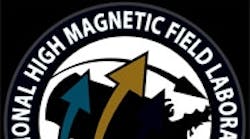Scientists who do research at the National High Magnetic Field Laboratory at The Florida State University, Tallahassee, Fla., once again have a new world-record magnet. At the end of 2009, engineers completed testing of a 36-tesla magnet, one that is more than 1,200 times stronger than a common refrigerator magnet. This achievement reestablishes the magnet lab as the world-record holder for the highest-field “resistive” magnet — a type of electromagnet that uses electricity to generate high magnetic fields. The new magnet beats the previous record of 35 tesla, jointly held by the magnet lab and the Grenoble High Magnetic Field Laboratory in France.
Resistive magnets are built in-house at the magnet lab using so-called “Florida Bitter” technology. Circular plates of copper sheet metal are stamped with cooling holes; insulators with the same pattern are placed between the plates and stacked to make a coil. Voltage is then run across the coil and current flows to make a magnetic field in the center. Because of the limits of available materials (both to conduct current and to minimize stress on the coils), engineers remained stuck at 35 tesla for four years.
Magnet lab engineers recently discovered that by adjusting the stacking pattern of the Bitter plates, they could increase the magnetic field without increasing stress on the coils. This modification means a higher magnetic field can be created using the same amount of power, 20 megawatts. By comparison, the magnet at the Grenoble lab achieves its 35 tesla using 22.5 megawatts of power.
The 36-tesla magnet, which has a 1.25-in. experimental space, will be used primarily for physics and materials science research. Jingping Chen, manager of the resistive magnet program, said the upgrade of the magnet is just a start, and that major upgrades are planned for many of the resistive magnets at the laboratory. To learn more, visit www.magnet.fsu.edu.

